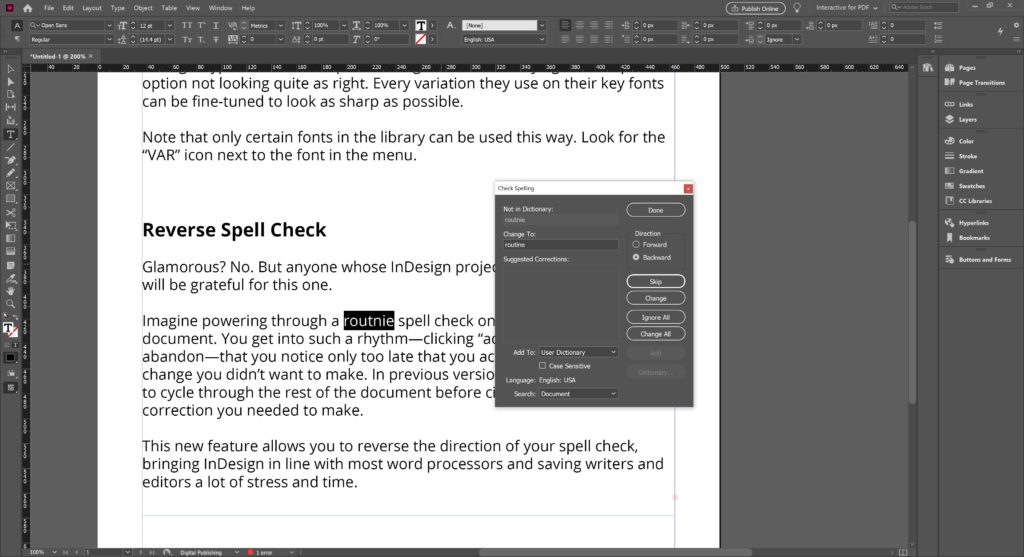

Then it loops back to the beginning of the story and moves forward until it reaches the point where it started. The spell check starts at the cursor and moves forward to the end of that story.

It’s easier to illustrate than it is to describe. When your cursor is in a text frame, it gets a little more complicated. These four unlinked frames were created in order from left to right, so the spell check proceeds the same way. When you don’t have your cursor in a text frame, the spell check starts with the first flagged word in the oldest frame and works its way to the newest frame (regardless of of page location). That chronological order is what InDesign follows during a spell check. Stories are ordered chronologically according to when they were put on a spread or pasteboard via drawing, duplicating, pasting, or dragging in from a Library or Snippet. The Spelling Loop-de-LoopĮver wonder how InDesign chooses the order in which it spell checks stories? In a complex document, it can send you bouncing back and forth from spread to spread. You can add a shortcut to invoke the Dictionary, but it won’t work when the Check Spelling dialog is open. There are no entries in Edit > Keyboard Shortcuts for these commands. The bad news is, there no shortcuts Ignore All or Change All, and you can’t even make up your own. Arrow keys move you through Suggested Corrections, and then you can press Enter for Change. Pressing Tab moves the focus back and forth between Change To and Suggested Corrections. Press it over and over to skip through flagged words until InDesign runs out of them. But you might not know that you can use Command/Ctrl+I to Skip also.

You probably know that Command/Ctrl+I opens the Check Spelling dialog. Keyboard Shortcuts: undocumented or non-existent More after the jump! Continue reading below↓įree and Premium members see fewer ads! Sign up and log-in today. My boss at the time told me it looked like I was playing pinball, and geek that I am, I probably would have kept feeding quarters into my Quadra to play XPress if I had to.įast forward to 2008: as soon as I finished the handouts, I vowed to examine the workings of that dialog box with a magnifying glass, to find out once and for all if it really sucked, or I had missed something. Spell checking was a mouse-free, bang-bang-bang-done task. Command+S for Skip, Command+L for Lookup, and Esc for Done. Back in Ye Olden Days, I used to race through spell checking Quark XPress documents with three very intuitive keyboard shortcuts.
Indesign spell check full#
If you use the mouse for everything, you might not care much, but I feel like I should be able to run a full spell check from the keyboard. Neither a panel nor a true modal dialog box, it walks in GUI limbo, with its weirdo brethren Find/Change and Tabs. Negative, but I always thought InDesign’s Check Spelling had, uh, room for improvement. I know, I just got through grumbling about the Gradient panel.

As I was spell checking the documents, I was struck by two things:Ī) the fact that I always type “stlye” instead of “style,” and really need to set up an autocorrect for it, andī) how much I dislike InDesign’s Check Spelling dialog box. Over the weekend, I put the finishing touches on the handouts for my two sessions at the InDesign Master Class.


 0 kommentar(er)
0 kommentar(er)
